kontrast-fotodesign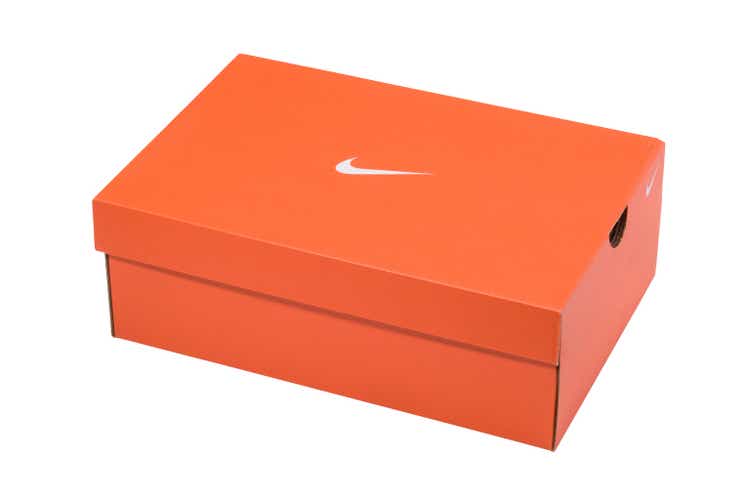
A more in-depth version of this report, including metric definitions and targets, was first shared with members of my Quality + Value Strategies subscription service in the Seeking Alpha Marketplace on September 6, 2022.
When first adding a slice of NIKE, Inc. (NYSE:NKE) to our family portfolio on June 6, 2017, I supported the purchase with my initial research report on the company and its common shares in the now embargoed Seeking Alpha article, NIKE: The Swoosh Is The Moat.
In the post, I wrote:
Phil Knight, the billionaire co-founder of NIKE, Inc. famously paid a graphic design student, attending a college where he taught accounting courses, $35 for creating a logo for his then athletic footwear start-up. The NIKE Swoosh is now as ubiquitous a branding icon as Coca-Cola’s (KO) scripted font and McDonald’s (MCD) golden arches.
In this updated primary ticker research report, I put NIKE and its common shares through my market-beating, data-driven investment research checklist of the value proposition, shareholder yields, fundamentals, valuation, and downside risks.
The resulting investment thesis:
Although NIKE’s value proposition, fundamentals, and downside risks collectively present a global brand powerhouse, the shareholder yields and valuation multiples suggest NKE shares are fully-priced, if not overpriced.
My current overall rating: Hold, based on a bullish view of the company and a neutral view of the stock.
Unless noted, all data presented is sourced from Seeking Alpha Premium and YCharts as of the intraday market on September 9, 2022; and intended for illustration only.
Outperforming Its Sector and Broader Market
NKE is a dividend-paying large-cap stock in the consumer discretionary sector’s footwear industry.
NIKE, Inc., and its subsidiaries design, develop, market, and sell men’s, women’s, and kids’ athletic footwear, apparel, equipment, and accessories worldwide. It also sells various related services. NIKE, Inc. was founded in 1964 and is headquartered in Beaverton, Oregon, USA.
My value proposition elevator pitch for NIKE:
The Swoosh is the moat, and it’s as wide as the logo is famous.
The chart below illustrates the stock’s performance against the Consumer Discretionary Select Sector SPDR Fund ETF (NYSE:XLY) and the SPDR S&P 500 ETF Trust (NYSE:SPY) since adding the shares to our family portfolio in early June 2017.
Ultimately, investing in individual common stocks should aim to beat the benchmark indices over time. For example, NKE has outperformed the total returns of its sector and the market over the past five-plus years.
My value proposition rating for NIKE: Bullish.
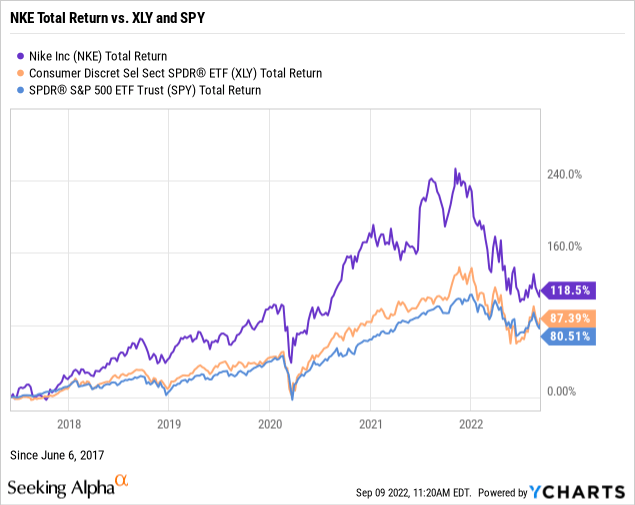
But Underperforming the 10-Year Treasury
As part of my due diligence, I average the total shareholder yields on earnings, free cash flow, and dividends to measure how a targeted stock compares to the prevailing yield on the 10-Year Treasury benchmark note. In other words, what is the equity bond rate of the common shares?
As demonstrated in the below chart, NKE was trading with an earnings yield of 3.41% and a free cash flow yield of 2.49%.
NIKE offers a modest dividend yield of 1.11%. However, its conservative 30.86% payout ratio indicates a safe, well-covered dividend with plenty of room for annual raises. Further, NKE was yielding 2.44% on our family portfolio’s split- and dividend-adjusted cost basis of $49.91 per share, or 133 basis points above the forward yield.
Next, take the average of the three shareholder yields to measure how the stock compares to the 3.29% prevailing yield on the 10-Year Treasury benchmark note. For example, the average shareholder yield for NKE was 2.34%. Further, the average yield was 2.78%, using the stock’s dividend yield on our cost basis. Conventional wisdom holds that equities are riskier than U.S. bonds. Thus, securities such as NKE that punish shareholders with yields lower than the government benchmark argue for owning the bond instead of the stock.
Remember that earnings and free cash flow yields are inverse valuation multiples, suggesting that NKE trades at a premium. I’ll further explore valuation later in this report.
My shareholder yields rating for NKE: Neutral.
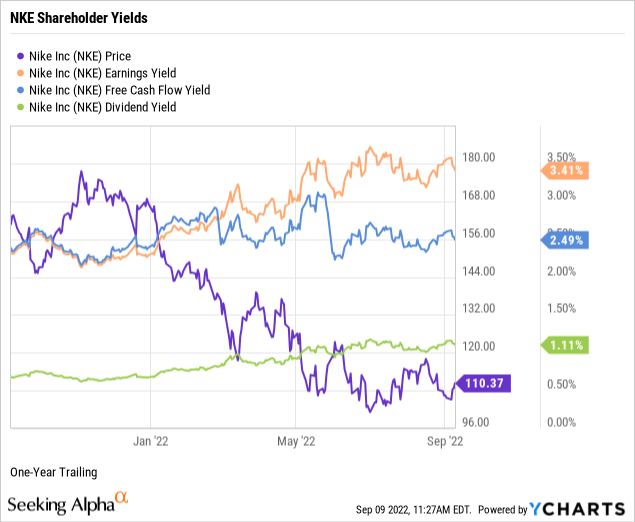
Outstanding Returns on Equity and Capital
Let’s explore the fundamentals of NIKE, uncovering the performance strength of the company’s senior management.
Per the below chart, NIKE had three-year annualized revenue growth of 4.88%, underperforming the 13.97% median growth for the consumer discretionary sector. On the contrary, NIKE had a trailing three-year double-digit pre-tax net profit margin of 12.94%, outperforming the sector’s single-digit median net margin of 5.86%.
NIKE was producing trailing three-year returns on equity, or ROE, of a resounding 41.91% against a median ROE of 15.43% for the sector.
Perhaps the NIKE board of directors’ stock repurchases are escalating the ROE, a good sign for shareholders. In addition, the board announced another $18 billion of share buybacks in its fiscal Q4 earnings release in late June 2022. However, will they be overpaying for their stock?
At 25.35%, NIKE’s return on invested capital or ROIC more than triples the sector’s median ROIC of 7.09%, indicating that NIKE’s senior executives are highly competent capital allocators. Further, its ROIC comfortably exceeds the company’s trailing weighted average cost of capital or WACC of 8.89% (Source of WACC: GuruFocus).
The positive, albeit modest revenue growth, double-digit net profit margin, and high returns on equity and capital indicate outstanding management performance in Beaverton.
My fundamentals rating for NIKE: Bullish.
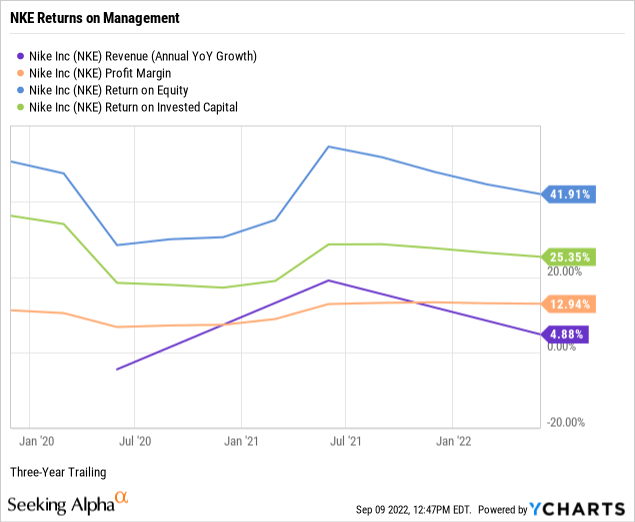
Nike Stock is Fully-Priced, if Not Overpriced
I rely on just four valuation multiples to estimate the intrinsic value of a targeted quality enterprise’s stock price.
At 3.82 times, NKE’s price-to-sales ratio or P/S was trailing the 0.83 times sales for the consumer discretionary sector and 2.40 times sales for the S&P 500. Thus, the weighted industry plus market sentiment suggests an overvalued stock price relative to NIKE’s topline. (Source of S&P 500 P/S: Charles Schwab & Co.)
NKE had a price-to-trailing earnings ratio or P/E of 29.44 times against a sector P/E of 13.15, indicating investor sentiment assigns a premium to the stock price relative to earnings per share. Further, NKE was trading at a higher multiple than the S&P 500’s recent overall P/E of 21.53. (Source of S&P 500 P/E: Barron’s).
At 34.37 times, NKE’s price-to-operating cash flow multiple was trading at a premium to the sector’s median of 12.35, indicating the market prices the stock far above fair value relative to current cash flows.
Against the broader sector median of 12.16 times, NKE was trading at 25.02 times enterprise value to operating earnings or EV/EBIT, signaling the stock was overbought or undersold by the market.
Weighting the preferred valuation multiples suggests the market assigns a premium to NIKE’s stock price relative to sales, earnings, cash flow, and enterprise value. Therefore, based on the fundamentals and valuation metrics uncovered in this report, risks and potential catalysts notwithstanding, I would call NKE a fully-priced, if not overpriced, stock of a legacy A-rated consumer enterprise.
My valuation rating for NKE: Neutral.
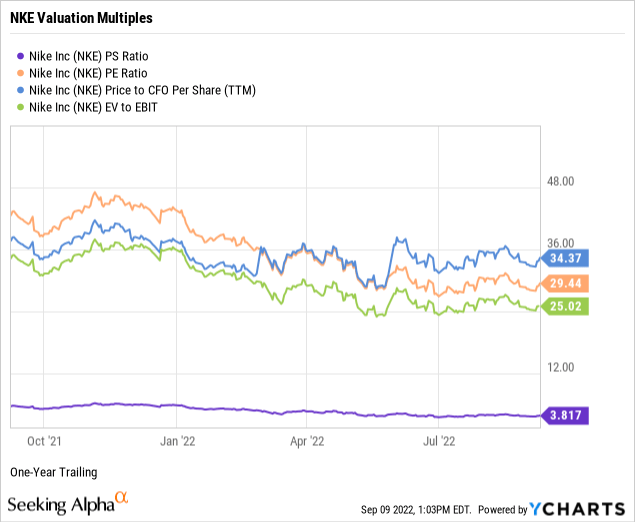
On the Contrary, Downside Risks Are Low
When assessing the downside risks of a company and its common shares, I focus on five metrics that, in my experience as an individual investor and market observer, often predict the potential risk/reward of the investment. Hence, I assign a downside risk-weighted rating of above average, average, below average, or low, biased toward below average and low-risk profiles.
Alpha-rich investors target companies with clear competitive advantages from their products or services. An investor or analyst can streamline the value proposition of an enterprise with an economic moat assignment of wide, narrow, or none. For example, the leading moat analyst, Morningstar, assigns NIKE a wide moat rating.
As reported on its May 2022 quarterly financial statements, NIKE’s long-term debt coverage was 3.16, or more than three times its current assets to long-term debt. In theory, the company could pay off 100% of its longer-term debt obligations in a crisis using its liquid assets, such as cash and equivalents, short-term investments, accounts receivables, and inventory.
In a further test of its paydown capacity, NIKE’s long-term debt to equity was a reasonably-leveraged 76.55%.
NIKE’s short-term debt coverage or current ratio was 2.63 times. Thus, its balance sheet provides substantial liquid assets to pay down 100% of its current liabilities, including accounts payable, accrued expenses, short-term borrowings, and income taxes.
NKE’s 60-month trailing beta was 1.02, while its 24-month beta was about equal at 1.13. With price volatility trading near the S&P 500 standard of 1.00, NKE presents as a market perform-type core holding.
The short interest percentage of the float for NKE was a bear paws-off of 1.13%. So perhaps the near-sighted traders view the stock as a safe wide-moat consumer cyclical with a loyal and sustainable base of customers and investors.
NIKE is a fundamentally superior company with a legendary value proposition and an attractive risk profile.
My downside risk rating for NKE: Low.
NKE Catalysts and Final Thoughts
Catalysts confirming or contradicting my overall hold investment thesis on the common shares of NIKE, Inc. include, but are not limited to:
- Confirmations: NIKE has organic revenue opportunities in emerging and developing markets, as most of its growth over the next several years will likely come from outside North America. NIKE’s direct-to-consumer sales strategy should improve margins and market share.
- Contradictions: As a global business exposed to geopolitical and macroeconomic issues, the latest and greatest disruptions in the coronavirus endemic could negatively impact NIKE’s sales.
Nevertheless, with a legendary value proposition represented by the ubiquitous Swoosh, strong fundamentals, and low downside risk, it would be challenging to question a savvy investor for taking a cautionary new position or accumulating additional shares on an established low-cost basis holding.


Be the first to comment